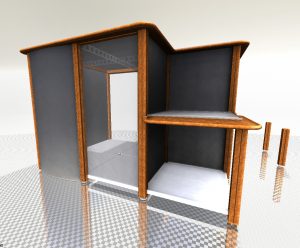Modularity is a great concept – in buildings – in products – in transport systems; anywhere there’s a need for flexibility combined with cost effective production.
But what is modular design? Put very simply it’s LEGO®; lots of pieces produced in quantity but capable of assembly into a number – or in the case of Lego, an unimaginable number – of design combinations.
We also ought to distinguish between modular product and pre-fabricated product as there’s often confusion between the two.
Pre-fabricated products are those which are made and assembled in one place – usually the factory -and then shipped complete or mostly complete to their point of end use. As opposed to assembling the product at the point of end use. This most often applies to building structures which traditionally were built from individual components – bricks and mortar for example – on site. Pre-fabricated buildings are built in a factory and moved whole to the site, this eliminates a lot of risk, cost and effort on site in favour of a more streamlined factory process.
Pre-fabricated products are also often modular as well, but they don’t have to be.
The key issue in modular design is the interaction of the various elements when they are assembled in their various configurations. The ease of assembly and the correct interfacing between the modular elements requires considerable design thought.
This is one of the huge benefits of using computer aided design systems (CAD) as most mainstream packages have features that facilitate modularity.
Here at Makersmith we use SolidWorks as our core 3D CAD system and this allows us to completely visualise and test designs before they are manufactured or constructed. In particular, SolidWorks has a “configuration” feature that allows you to easily create variations of a basic part design as well as easily assemble multiple parts into a range of different assemblies. This process works equally well for large structures such as buildings as it does for simple individual parts.
The short video shows how a simple model of a piece of pipe can easily be configured with length and diameter variations – all with the same basic geometry. It’s really a very powerful tool indeed.

We use the same process to construct modular structures that are assembled from many hundreds of parts:
The great thing about doing this is that it’s easy to check all the interfaces and connections to ensure that design detail is fully resolved and that there are no unanswered questions.
Designing and developing modular systems is really satisfying and it’s great when they go together and simply work; it’s probably because we still enjoy playing with LEGO®!
If you want to see more about an early modular building system then this is a great article:
http://www.metropolismag.com/cities/the-enduring-lives-of-sasa-machtigs-modular-creations/
 Working within a defined framework means that designers have more freedom to focus on being creative without having to think too much about the overall process and whether they are on the right track. It’s a bit like going out for a walk and going from waymarker to waymarker. You can explore and admire the view but when you get to the next signpost you know you are on the right route to reach the end.
Working within a defined framework means that designers have more freedom to focus on being creative without having to think too much about the overall process and whether they are on the right track. It’s a bit like going out for a walk and going from waymarker to waymarker. You can explore and admire the view but when you get to the next signpost you know you are on the right route to reach the end.